PEUGEOT 5008 2016 Owners Manual
Manufacturer: PEUGEOT, Model Year: 2016, Model line: 5008, Model: PEUGEOT 5008 2016Pages: 364, PDF Size: 12.98 MB
Page 211 of 364

209
5008_en_Chap09_verifications_ed01-2015
Topping-up the AdBlue® additive
Precautions in use
Keep AdBlue® out of the reach of
children, in its original bottle.
Never transfer AdBlue
® to another
container: it would lose its purity. Use only AdBlue
® additive that meets
the ISO 22241 standard.
The AdBlue® additive is an urea-based
solution. This liquid is non-flammable,
colourless and odourless (kept in a cool area).
In the event of contact with the skin, wash
the affected area with soap and water. In the
event of contact with the eyes, wash (irrigate)
the eyes with large amounts of water or with
an eye wash solution for at least 15 minutes.
If a burning sensation or irritation persists, get
medical attention.
If swallowed, immediately wash out the mouth
with clean water and then drink plenty of water.
In certain conditions (high ambient
temperature, for example), the risk of release
of ammonia cannot be excluded: do not inhale
the product. Ammonia vapour has en irritant
effect on mucous membranes (eyes, nose and
throat). Never dilute the additive with water.
Never pour the additive into the Diesel
fuel tank.
The supply in a non-drip bottle simplifies
toping-up. You can obtain 1.89 litre (half a US
gallon) bottles from a PEUGEOT
dealer or a
qualified workshop.
Never top-up from an AdBlue
®
dispenser reserved for heavy goods
vehicles.
Filling the AdBlue
® tank is an operation
included in every routine service on your
vehicle by a PEUGEOT dealer or a qualified
workshop.
Nevertheless, given the capacity of the tank,
it may be necessary to top-up the additive
between services, more particularly if an alert
(warning lamps and a message) signals the
requirement.
You can got to a PEUGEOT dealer or a
qualified workshop.
If you envisage topping-up yourself, please
read the following warnings carefully.
9
Checks
Page 212 of 364
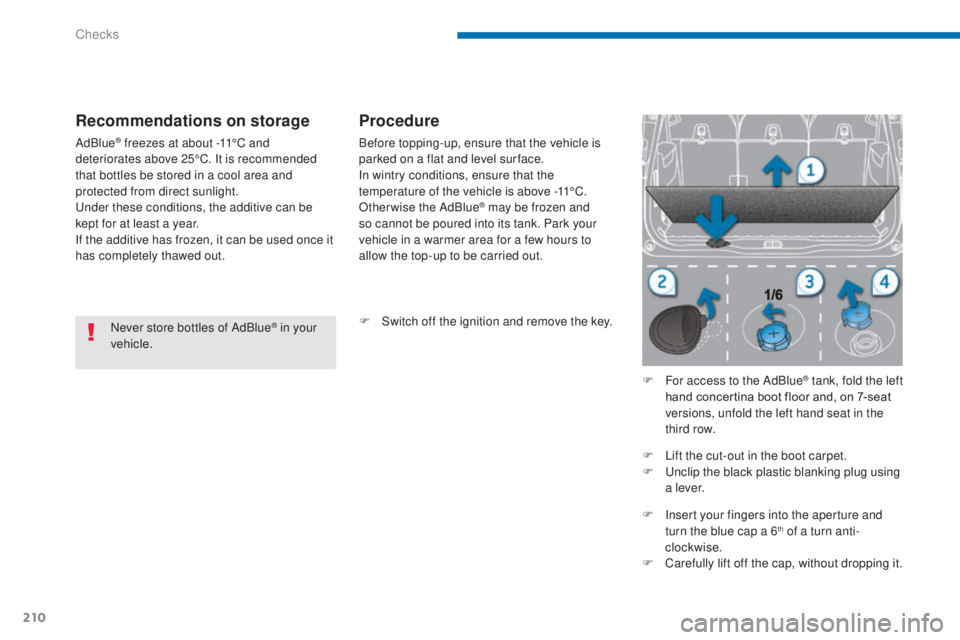
210
5008_en_Chap09_verifications_ed01-2015
Never store bottles of AdBlue® in your
vehicle.
Recommendations on storage
AdBlue® freezes at about -11°C and
deteriorates above 25°C. It is recommended
that bottles be stored in a cool area and
protected from direct sunlight.
Under these conditions, the additive can be
kept for at least a year.
If the additive has frozen, it can be used once it
has completely thawed out.
Procedure
Before topping-up, ensure that the vehicle is
parked on a flat and level sur face.
In wintry conditions, ensure that the
temperature of the vehicle is above -11°C.
Otherwise the AdBlue
® may be frozen and
so cannot be poured into its tank. Park your
vehicle in a warmer area for a few hours to
allow the top-up to be carried out.
F
S
witch off the ignition and remove the key. F
F
or access to the AdBlue
® tank, fold the left
hand concertina boot floor and, on 7-seat
versions, unfold the left hand seat in the
third row.
F
L
ift the cut-out in the boot carpet.
F
U
nclip the black plastic blanking plug using
a l eve r.
F
I
nsert your fingers into the aperture and
turn the blue cap a 6
th of a turn anti-
clockwise.
F
C
arefully lift off the cap, without dropping it.
Checks
Page 213 of 364
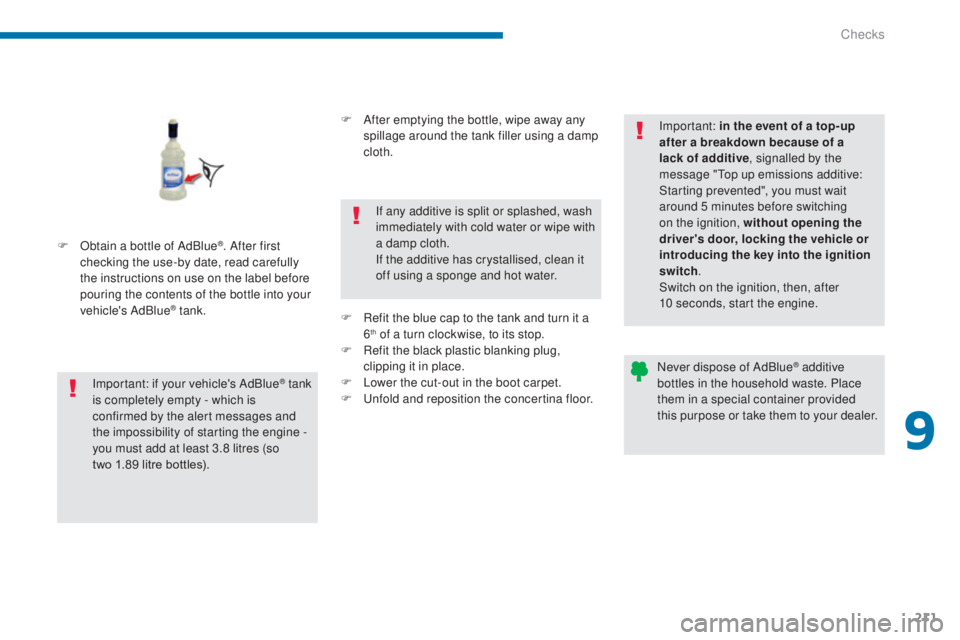
211
5008_en_Chap09_verifications_ed01-2015
F Obtain a bottle of AdBlue®. After first
checking the use-by date, read carefully
the instructions on use on the label before
pouring the contents of the bottle into your
vehicle's AdBlue
® tank.
Important: if your vehicle's AdBlue
® tank
i
s completely empty - which is
confirmed by the alert messages and
the impossibility of starting the engine
-
you must add at least 3.8 litres (so
two
1.89 litre bottles). F
A
fter emptying the bottle, wipe away any
spillage around the tank filler using a damp
cloth.
If any additive is split or splashed, wash
immediately with cold water or wipe with
a damp cloth.
If the additive has crystallised, clean it
off using a sponge and hot water.
F
R
efit the blue cap to the tank and turn it a
6
th of a turn clockwise, to its stop.
F
R
efit the black plastic blanking plug,
clipping it in place.
F
L
ower the cut-out in the boot carpet.
F
U
nfold and reposition the concertina floor. Important: in the event of a top-up
after a breakdown because of a
lack of additive
, signalled by the
message "Top up emissions additive:
Starting prevented", you must wait
around 5 minutes before switching
on the ignition, without opening the
driver's door, locking the vehicle or
introducing the key into the ignition
switch .
Switch on the ignition, then, after
10 seconds, start the engine.
Never dispose of AdBlue
® additive
bottles in the household waste. Place
them in a special container provided
this purpose or take them to your dealer.
9
Checks
Page 214 of 364
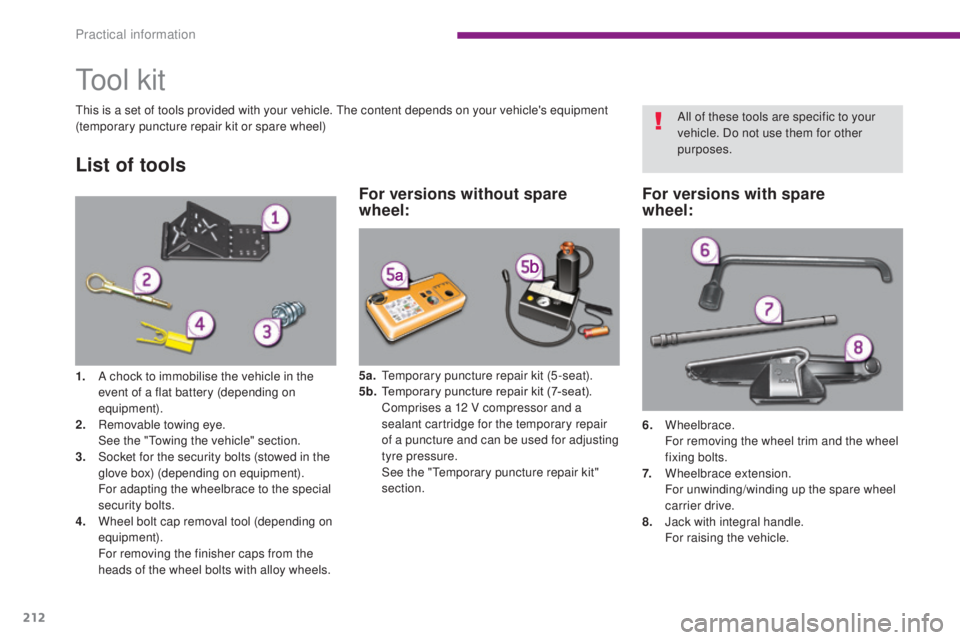
212
5008_en_Chap10_infos-pratiques_ed01-2015
Tool kit
This is a set of tools provided with your vehicle. The content depends on your vehicle's equipment
(temporary puncture repair kit or spare wheel)
List of tools
5a. Temporary puncture repair kit (5-seat).
5b. T emporary puncture repair kit (7-seat).
C
omprises a 12 V compressor and a
sealant cartridge for the temporary repair
of a puncture and can be used for adjusting
tyre pressure.
S
ee the "Temporary puncture repair kit"
section. 6.
Wheelbrace.
F
or removing the wheel trim and the wheel
fixing bolts.
7.
W
heelbrace extension.
F
or unwinding/winding up the spare wheel
carrier drive.
8.
J
ack with integral handle.
F
or raising the vehicle.
1. A c
hock to immobilise the vehicle in the
event of a flat battery (depending on
equipment).
2.
R
emovable towing eye.
S
ee the "Towing the vehicle" section.
3.
S
ocket for the security bolts (stowed in the
glove box) (depending on equipment).
F
or adapting the wheelbrace to the special
security bolts.
4.
W
heel bolt cap removal tool (depending on
equipment).
F
or removing the finisher caps from the
heads of the wheel bolts with alloy wheels. All of these tools are specific to your
vehicle. Do not use them for other
purposes.
For versions without spare
wheel:
For versions with spare
wheel:
Practical information
Page 215 of 364
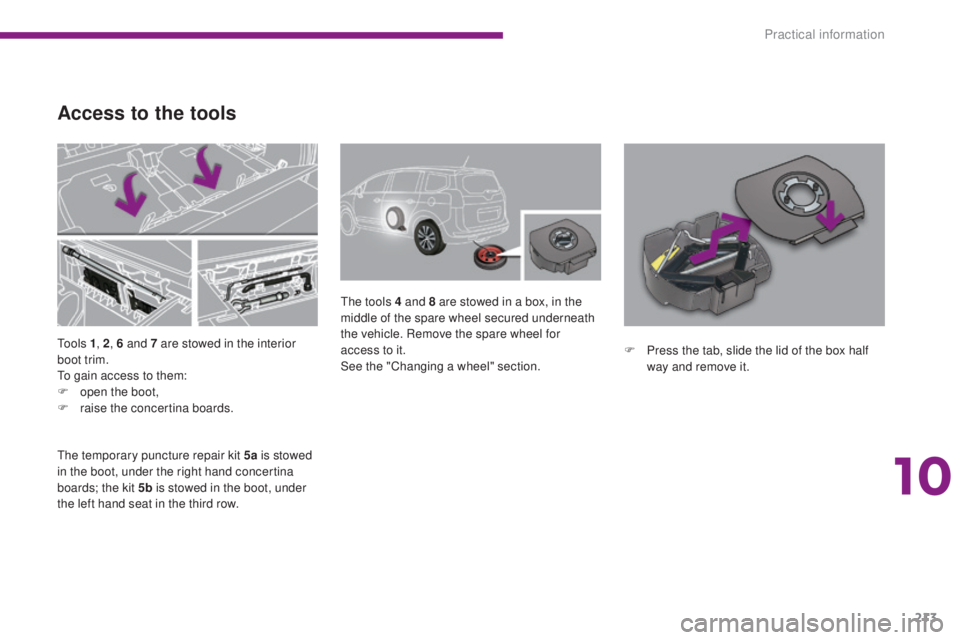
213
5008_en_Chap10_infos-pratiques_ed01-2015
To o l s 1, 2, 6 and 7 are stowed in the interior
boot trim.
To gain access to them:
F
o
pen the boot,
F
r
aise the concertina boards. The tools 4 and 8 are stowed in a box, in the
middle of the spare wheel secured underneath
the vehicle. Remove the spare wheel for
access to it.
See the "Changing a wheel" section.
Access to the tools
The temporary puncture repair kit 5a
is stowed
in the boot, under the right hand concertina
boards; the kit 5b is stowed in the boot, under
the left hand seat in the third row. F
P
ress the tab, slide the lid of the box half
way and remove it.
10
Practical information
Page 216 of 364
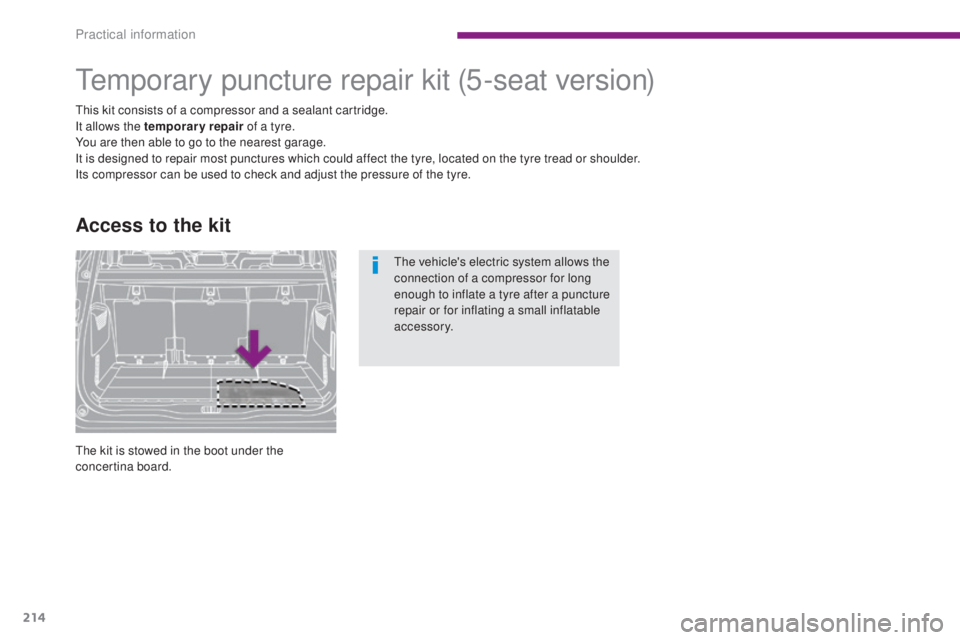
214
5008_en_Chap10_infos-pratiques_ed01-2015
Temporary puncture repair kit
This kit consists of a compressor and a sealant cartridge.
It allows the temporary repair of a tyre.
You are then able to go to the nearest garage.
It is designed to repair most punctures which could affect the tyre, located on the tyre tread or shoulder.
Its compressor can be used to check and adjust the pressure of the tyre.
Access to the kit
(5-seat version)
The kit is stowed in the boot under the
concertina board. The vehicle's electric system allows the
connection of a compressor for long
enough to inflate a tyre after a puncture
repair or for inflating a small inflatable
accessory.
Practical information
Page 217 of 364
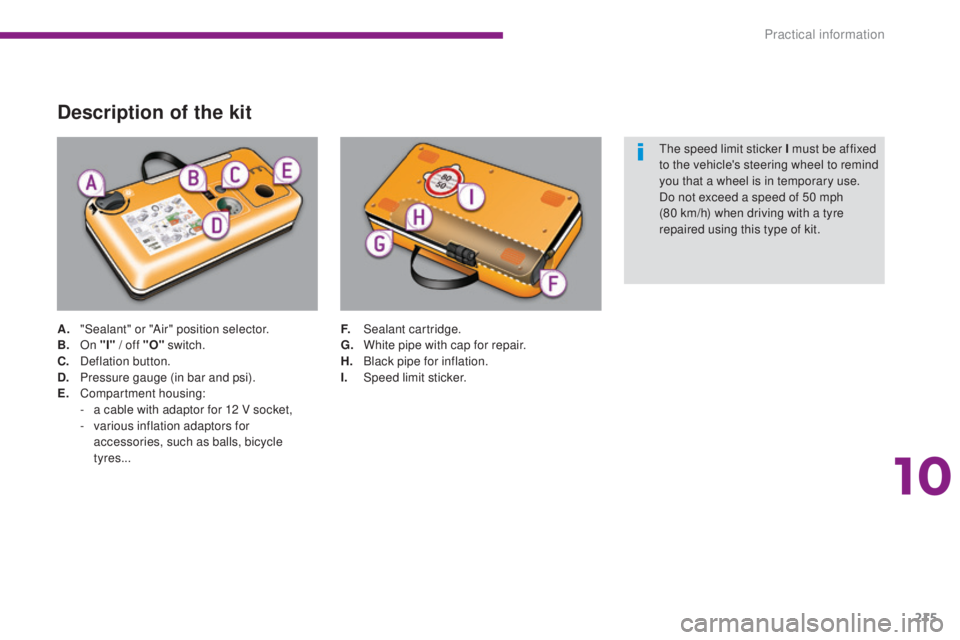
215
5008_en_Chap10_infos-pratiques_ed01-2015
Description of the kit
A. "Sealant" or "Air" position selector.
B. On "I" / off "O" switch.
C.
D
eflation button.
D.
P
ressure gauge (in bar and psi).
E.
C
ompartment housing:
-
a c
able with adaptor for 12 V socket,
-
v
arious inflation adaptors for
accessories, such as balls, bicycle
tyres... F. S
ealant cartridge.
G. W hite pipe with cap for repair.
H.
B
lack pipe for inflation.
I.
Spe
ed limit sticker.The speed limit sticker I must be affixed
to the vehicle's steering wheel to remind
you that a wheel is in temporary use.
Do not exceed a speed of 50 mph
(80
km/h) when driving with a tyre
repaired using this type of kit.
10
Practical information
Page 218 of 364
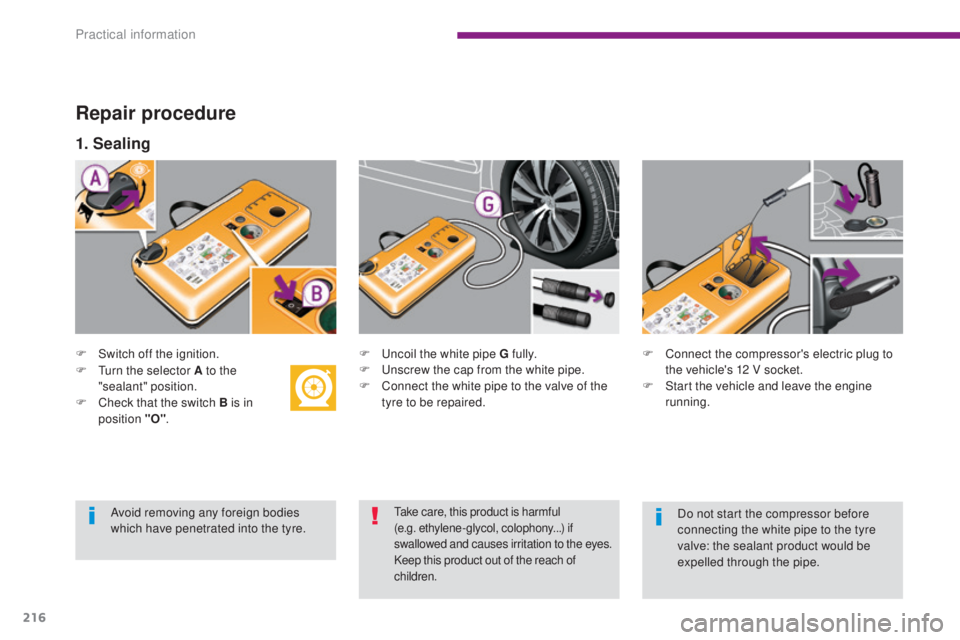
216
5008_en_Chap10_infos-pratiques_ed01-2015
Repair procedure
F Switch off the ignition.F U ncoil the white pipe G fully.
F U nscrew the cap from the white pipe.
F
C
onnect the white pipe to the valve of the
tyre to be repaired. F
C onnect the compressor's electric plug to
the vehicle's 12 V socket.
F
S
tart the vehicle and leave the engine
running.
1. Sealing
F Turn the selector A to the "sealant" position.
F
C
heck that the switch B is in
position "O" .
Take care, this product is harmful
(e.g.
ethylene-glycol, colophony...) if
swallowed and causes irritation to the eyes.
Keep this product out of the reach of
children.Avoid removing any foreign bodies
which have penetrated into the tyre. Do not start the compressor before
connecting the white pipe to the tyre
valve: the sealant product would be
expelled through the pipe.
Practical information
Page 219 of 364
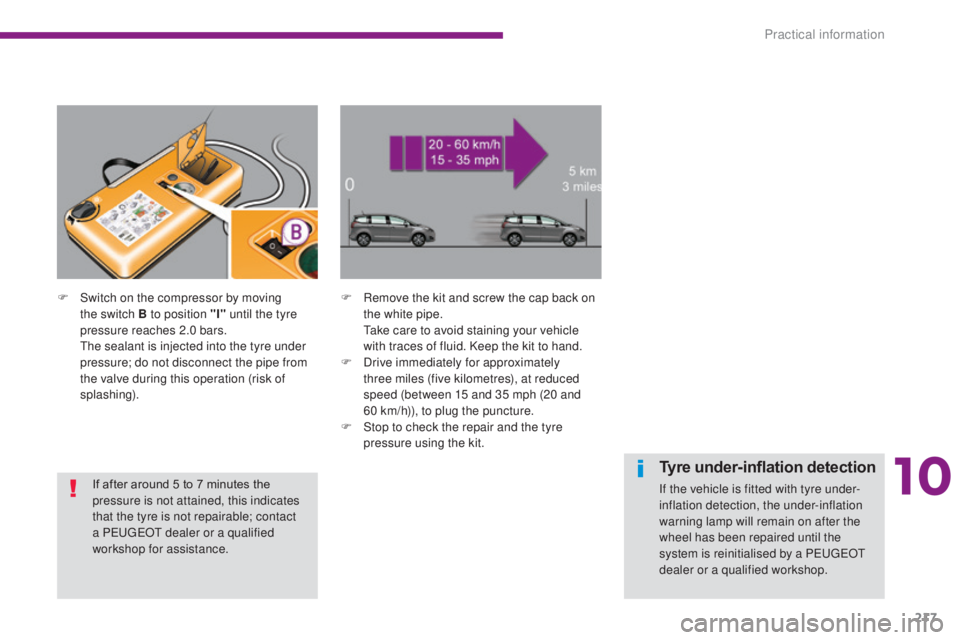
217
5008_en_Chap10_infos-pratiques_ed01-2015
F Switch on the compressor by moving the switch B to position "I" until the tyre
pressure reaches 2.0 bars.
T
he sealant is injected into the tyre under
pressure; do not disconnect the pipe from
the valve during this operation (risk of
splashing). F
R emove the kit and screw the cap back on
the white pipe.
T
ake care to avoid staining your vehicle
with traces of fluid. Keep the kit to hand.
F
D
rive immediately for approximately
three miles (five kilometres), at reduced
speed (between 15 and 35 mph (20 and
60
km/h)), to plug the puncture.
F
S
top to check the repair and the tyre
pressure using the kit.
Tyre under-inflation detection
If the vehicle is fitted with tyre under-
inflation detection, the under-inflation
warning lamp will remain on after the
wheel has been repaired until the
system is reinitialised by a PEUGEOT
dealer or a qualified workshop.
If after around 5 to 7 minutes the
pressure is not attained, this indicates
that the tyre is not repairable; contact
a PEUGEOT dealer or a qualified
workshop for assistance.
10
Practical information
Page 220 of 364
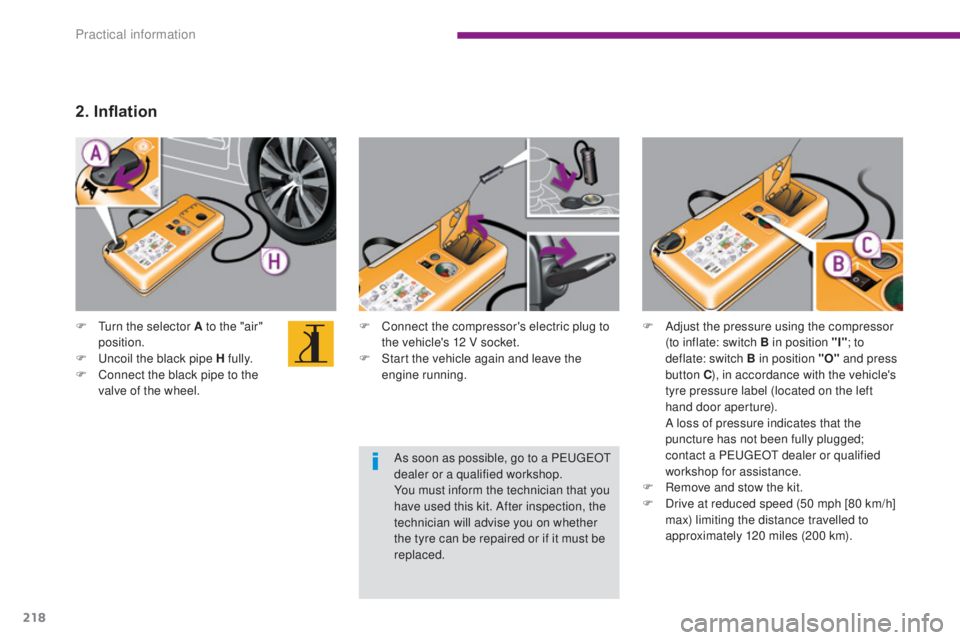
218
5008_en_Chap10_infos-pratiques_ed01-2015
F Connect the compressor's electric plug to the vehicle's 12 V socket.
F
S
tart the vehicle again and leave the
engine running.
F
T
urn the selector A to the "air"
position.
F
U
ncoil the black pipe H fully.
F
C
onnect the black pipe to the
valve of the wheel.
2. Inflation
F Adjust the pressure using the compressor (to inflate: switch B in position "I" ; to
deflate: switch B
in position "O" and press
button C ), in accordance with the vehicle's
tyre pressure label (located on the left
hand door aperture).
A l
oss of pressure indicates that the
puncture has not been fully plugged;
contact a PEUGEOT dealer or qualified
workshop for assistance.
F
R
emove and stow the kit.
F
D
rive at reduced speed (50 mph [80 km/h]
max) limiting the distance travelled to
approximately 120 miles (200 km).
As soon as possible, go to a PEUGEOT
dealer or a qualified workshop.
You must inform the technician that you
have used this kit. After inspection, the
technician will advise you on whether
the tyre can be repaired or if it must be
replaced.
Practical information